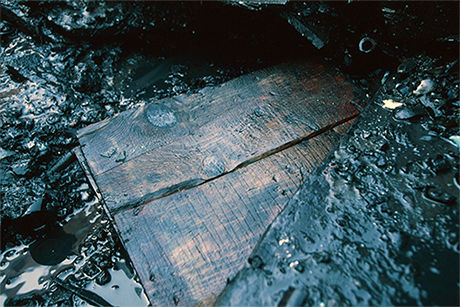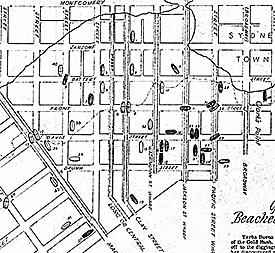Unearthing a Forgotten Ship
In 1998, archaeologist Allen Pastron of Archeo-Tec, the preeminent excavator of San Francisco's archaeology and owner of an Oakland archaeological consulting firm, began negotiations with a New York firm, Masterworks. Masterworks was planning to build a new hotel at the corner of Clay and Battery streets. Pastron knew, thanks to historical research, that the remains of the General Harrison were likely to lie buried at the site.
Thanks to various laws, developers in San Francisco need to conduct an archaeological reconnaissance before any construction proceeds. Pastron assembled a crew on the site and with a powerful augur, placed a series of boreholes into the earth. On one hole, the drill but deep into wood, and then spit out a section of oak covered with copper. It was a section of the ship's keel, or backbone, still sheathed with copper that once protected the hull from marine organisms.
Just how much of the ship had survived was unknown. In early September, 2001, construction crews cleared away the concrete floor of the basement of the recently demolished building on the site, and dug into the wet sand beneath it. Within a matter of a few hours, the outline of the ship began to emerge. About two-thirds, or 81 feet of the 126-foot long hull was exposed. One end of the ship lay beneath an adjacent building. Pastron had uncovered the long-forgotten General Harrison. I then arrived, on September 9, to study and document the ship. My own career as a maritime archaeologist began 23 years earlier, and a block away, when the storeship Niantic emerged from the mud on another construction project. Now, in an amazing coincidence, my career with lost ships comes full circle.
General Harrison, view forward from the stern, September 2001. Photo by James Delgado. Click on map to zoom in for a closer look.
Arriving at the site, you are struck by how this small hole in the midst of all the high-rises acts like a portal to the past. Every day, hundreds of pedestrians stop, look down at the ship nestled in the mud, and stare. For those of us privileged with a closer look, it is a steep climb down a construction ladder, and then over loose sand and slippery mud until you reach the timbers of the ship. The General Harrison burned to her waterline, and so only a third of the ship's once massive hull remain. Cleared of mud, the hold now lies largely empty. The ship was cleaned out after the fire, probably in 1856. That year, "ship-breaker" Charles Hare, working with a crew of local Chinese labourers, began to clear the waterfront. Dozens of old ships lay off the Market Street wharf on "Rotten Row." Hare and his crew bought the ships and dismantled them piecemeal, placing "shattered timbers in one pile, the iron bolts in another, the copper in another…and so in a short time all that remains…[is] so many ghastly piles of marine debris."
What we find inside the General Harrison is the unmistakeable evidence of the Chinese ship breakers. A thick iron pry-bar for wrenching free thick copper bolts lies in one area. Nearby is a pile of iron bolts, stacked ready for removal. Washing away the mud, we find a broken rice bowl, a shattered bottle, and several pairs of worn-out boots. It is as if the workers have just left. They left the job undone, though. The ship is only partially broken down – nearly every bit of valuable copper is gone, but the work stopped short of cutting apart the wooden hull. That might mean that the General Harrison's scrapping took place around April 1857, when Hare told a San Francisco newspaper reporter that "business must soon all but stop" as there was no longer enough work for him to keep his labourers busy. As I look at the unfinished, half-cut planks, at sections of timber lying where axes were chopping them up – the marks still fresh – and the discarded boots, bowl and bottle, I am reminded that this is yet another moment frozen in time.
That sense of timelessness certainly comes through alongside the ship. The tons of burned material, as we sort through it, yield more than just melted glass, twisted iron, and charred wood. The fire that destroyed San Francisco – and the General Harrison – on May 3-4, 1851 was intense. It also flashed over the ship so quickly that some items fell into the tidal shallows and mud practically unharmed. Using the hoses, we slowly, carefully peeled away layers of ash, cinders and mud to reveal a door with its brass pull-ring still bright and shiny – and with traces of paint on the wood. A broken up box bears the partial trademark and name of a Cuban cigar company.

Two photos of the crate of wine, in situ. Roll your cursor over the image to see the wine case with the top removed. Photos by James Delgado.
Then, as the water washes away the thick black sediment, I spot the corner of a small pine box. Carefully, and yet eagerly, we work for the next two hours to slowly expose it from beneath fallen timbers and piles of broken glass. It is an intact crate. Finally, once the box is clear of debris and cleaned, we photograph and measure it, and survey its location in on our site map. Only then do I carefully open the lid. Nestled inside are twelve bottles, still packed in straw. Soggy and stuck to the bottles, the straw easily yields as I pick up one bottle. The cork is intact and covered with a silver foil cap. The label is gone, but as I wipe the bottle clean and hold it up, the sun illuminates the red wine inside.
Even more bottles – including Madeira, brandy, sherry and champagne – emerge from the mud, including unbroken samples still full of liquid. More crates, some of them crushed, show that these were the liquors and wines stored inside the General Harrison, and ultimately cleared out of the burned hulk when Hare's workers began their dismantling. What might be samples of pâté also emerge. The fancy foods inside the storeship were probably all destroyed, I think. Then I reach down and pick up a perfectly preserved peanut, still in its shell, and only slightly charred. Other surprises include rolls and bolts of charred cloth, lying next fused and melted kegs of nails and tacks. A glint of bright red reveals a bag of small red glass beads, and bits of hardware provide a hint of what was once nice furniture.

A portion of a map of San Francisco's buried ships produced by the San Francisco Maritime Museum in 1965. (Large View).
The General Harrison is now, once again, buried beneath the city. Workers covered her over today to make way for the new hotel on the site. Rather than destroy her, Masterworks put the General Harrison back into her time capsule. The tons of burned artifacts were sorted in the laboratory and yielded even more surprises, including sacks of beans and barley, the handle of a small pistol, and other reminders of global maritime connections that arrived by sea and poured into the hold of the storeship and then into the city and region. Nine years after the dig, our report is finished, as well as a scholarly volume on the maritime origins and excavations of the buried Gold Rush port. Images from the dig, plaques and artistic representations of General Harrison decorate the Club Quarters Hotel that cover the General Harrison. They all help remind San Franciscans and their visitors of a city borne of the sea, as well as the romance of a buried waterfront that still holds the bones of the ships that settled this town in the days of the Gold Rush.
Return to Previous post.
Return to In The Field home page.
Comments, suggestions, or questions can be directed to research@themua.org
Additional information related to this topic by Dr. Delgado can be found here:
Gold Rush Port
The Maritime Archaeology of San Francisco's Waterfront




